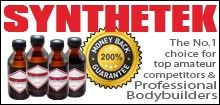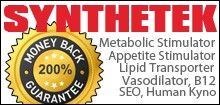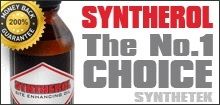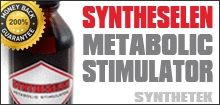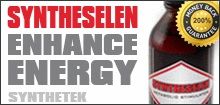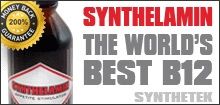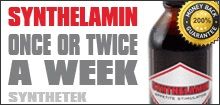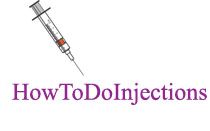I would be surprised if any studies have been done on optimal steroid use for bodybuilders, or anything really even remotely in that ballpark
The only "literature" I know of is Arthur Rea's old "building the perfect beast" which talks about this, but that's not even remotely a "study" either
Show us these studies
Same reason an alcoholic who can't get drunk no matter how much he drinks can get drunk on just a few beers if he stops drinking for a month or two
The body is always working to find homeostasis, virtually every drug always starts to lose effectiveness over time, the body adapts, etc.
With steroids it's somewhat different than say with an SSRI or something like that. You won't reach a point where you suddenly start to slowly shrink even though you are using the same amount, like people with depression/anxiety can sometimes start to slip back into it unless they increase their meds. But if you come off the steroids for long enough to "resensitize" but short enough so you don't lose significant muscle, you can use that initial bump when you go back up to your advantage.
Lots of pros have talked about this. Fuoad Abiad said on his podcast that the one off-season in his career he made his biggest gains was when he took a couple months offs.
You are using an out of date browser. It may not display this or other websites correctly.
You should upgrade or use an alternative browser.
You should upgrade or use an alternative browser.
Which nationality is most extreme with gear
- Thread starter traininsane11
- Start date
- Status
- Not open for further replies.
- Joined
- Jul 4, 2017
- Messages
- 572
Australia has changed a lot in the last 10 years
20 years ago no one did gear (it was too hard to get and only possible in hard core gyms with hard core bodybuilders and not spoken about).
Same with Cocaine. No one did it and it was impossible to get.
Last 10 years steroids and cocaine have blown up. In particular cocaine. Every mofo is doing blow friday and saturday nights in drinking establishments.
20 years ago no one did gear (it was too hard to get and only possible in hard core gyms with hard core bodybuilders and not spoken about).
Same with Cocaine. No one did it and it was impossible to get.
Last 10 years steroids and cocaine have blown up. In particular cocaine. Every mofo is doing blow friday and saturday nights in drinking establishments.
Based on this passage, steroids positively impact your receptors
Endogenous anabolic steroids such as testosterone and dihydrotestosterone and synthetic anabolic steroids mediate their effects by binding to and activating androgen receptors. In skeletal muscle, anabolic steroids regulate the transcription of target genes that control the accumulation of DNA in skeletal muscle required for muscle growth.[4][5][3]
Anabolic steroids also upregulate and increase the number of androgen receptors, thus enabling increased training intensity and indirectly contributing to increased muscle size and strength. They also have a stimulatory effect on the brain through their diverse effects on various central nervous system neurotransmitters, antagonism of glucocorticoids, and stimulation of the growth hormone-insulin-like growth factor-1 axis."
- Joined
- Apr 20, 2009
- Messages
- 7,647
What has changed..is it easier to import? Or have penalties for use relaxed at all?Australia has changed a lot in the last 10 years
20 years ago no one did gear (it was too hard to get and only possible in hard core gyms with hard core bodybuilders and not spoken about).
Same with Cocaine. No one did it and it was impossible to get.
Last 10 years steroids and cocaine have blown up. In particular cocaine. Every mofo is doing blow friday and saturday nights in drinking establishments.
- Joined
- Jan 15, 2012
- Messages
- 3,118
what are you drawing our attention here to? That steroids upregulate androgen receptors? What relevance do you think this has?
To date, the supposed hypothesis of AR downregulation caused by AAS use is a mere anecdote that cannot be translated into the real-world scenario of muscle hypertrophy because, to the best of our knowledge, only a former study published nearly three decades ago suggests T-induced downregulation of ARs using rat cavernosum smooth muscle, in which finasteride was used to increase T levels instead of T administration [37].
Nevertheless, taking into account the relationship between ARs and skeletal muscle receptors, it is unsubstantiated to claim that there is downregulation of ARs in response to AAS administration. There is an undeniable lack of evidence to support AAS use downregulating ARs, even when considering animal studies. Amid the paucity of direct evidence, a single, older study using cells from the corpus cavernosum of rats reported that T led to downregulation of ARs [37]; however, instead of administrating T, finasteride was used as a means of increasing T concentration because of its actions in inhibiting 5-alpha reductase—then converting T to dihydrotestosterone [37]. In contrast to this study, another in vitro experiment showed that T administration upregulates AR in cultured the skeletal muscle satellite cells and myotubes of a porcine [38]. Thus, the latter study [38] portrays the biological nexus between AASs and AR regulation with more specificity in an attempt to understand the mechanisms inherent in the muscle-building plateau than the former one [37]. Furthermore, a couple of human studies show that T and oxandrolone upregulate myocyte AR [39,40]
Many animal and human studies support that T administration leads to satellite cell proliferation and increases the number of myonuclei [58,59,60]. More importantly, supraphysiological doses of T increase the number of satellite cells and myonuclei in healthy men [60]. After 20 wk of 125, 300, or 600 mg weekly doses of T enanthate, Sinha-Hikim et al., detected significant increases in myonuclear number for those subjects who received 300 (2.5 ± 0.8 to 5.0 ± 0.8%, n = 8) and 600 mg (2.5 ± 0.5 to 15.0 ± 1.5%, n = 5) [60]. Equally important, the increase in satellite cell number correlated with changes in total (r = 0.548) and free T concentrations (r = 0.468) [60].
Given the well-established effects of AASs on orchestrating satellite cells, one can contemplate crosstalk between ARs and signaling pathways involved in activating satellite cells from quiescence to proliferation, as the binding of AASs to ARs is imperative to afford satellite cell-mediated hypertrophy [61].
Hence, based on the available literature, the hypothesis that the use of T and other AASs promote AR downregulation in skeletal muscle is an unwarranted assumption, as their effects on muscle mass accretion are evident.
Nevertheless, taking into account the relationship between ARs and skeletal muscle receptors, it is unsubstantiated to claim that there is downregulation of ARs in response to AAS administration. There is an undeniable lack of evidence to support AAS use downregulating ARs, even when considering animal studies. Amid the paucity of direct evidence, a single, older study using cells from the corpus cavernosum of rats reported that T led to downregulation of ARs [37]; however, instead of administrating T, finasteride was used as a means of increasing T concentration because of its actions in inhibiting 5-alpha reductase—then converting T to dihydrotestosterone [37]. In contrast to this study, another in vitro experiment showed that T administration upregulates AR in cultured the skeletal muscle satellite cells and myotubes of a porcine [38]. Thus, the latter study [38] portrays the biological nexus between AASs and AR regulation with more specificity in an attempt to understand the mechanisms inherent in the muscle-building plateau than the former one [37]. Furthermore, a couple of human studies show that T and oxandrolone upregulate myocyte AR [39,40]
Many animal and human studies support that T administration leads to satellite cell proliferation and increases the number of myonuclei [58,59,60]. More importantly, supraphysiological doses of T increase the number of satellite cells and myonuclei in healthy men [60]. After 20 wk of 125, 300, or 600 mg weekly doses of T enanthate, Sinha-Hikim et al., detected significant increases in myonuclear number for those subjects who received 300 (2.5 ± 0.8 to 5.0 ± 0.8%, n = 8) and 600 mg (2.5 ± 0.5 to 15.0 ± 1.5%, n = 5) [60]. Equally important, the increase in satellite cell number correlated with changes in total (r = 0.548) and free T concentrations (r = 0.468) [60].
Given the well-established effects of AASs on orchestrating satellite cells, one can contemplate crosstalk between ARs and signaling pathways involved in activating satellite cells from quiescence to proliferation, as the binding of AASs to ARs is imperative to afford satellite cell-mediated hypertrophy [61].
Hence, based on the available literature, the hypothesis that the use of T and other AASs promote AR downregulation in skeletal muscle is an unwarranted assumption, as their effects on muscle mass accretion are evident.
I don’t read good, but I think the “receptor down regulation” is pretty much dead in the water in real studies of physiology.
Now in meathead terms….yea week 20 of test/tren/drol/slin when your liver values are 300, blood pressure 160/100, fasting BG 110….yea gains slow because your systemic stress is fucking at multiple organ system failure levels
NOT because of receptor down regulation
Now in meathead terms….yea week 20 of test/tren/drol/slin when your liver values are 300, blood pressure 160/100, fasting BG 110….yea gains slow because your systemic stress is fucking at multiple organ system failure levels
NOT because of receptor down regulation
The constant on Arabs seems the Anadrol not really the rest of the drugs which are quite standard.I talk with some arabs
My friend is iffbb pro and is arab
They go heavy on eq and primo
My friend is 117 kg
500 test
1g primo
1g eq
100 anadrol prewo
15 iu gh
10 slin pre
10 post
I can't imagine running this stack, my E2 would be at 10pg/ml...
- Joined
- Nov 6, 2003
- Messages
- 502
Interesting topic choice and post. It is fun to see the responses.Bit of a fun question for those who coach people of high levels from different parts of the world or anyone with experience personal or otherwise
How do the drug protocols and general outlook/practices vary country to country
For example
Uk - for some time have been caught up in the high mast/primo and low test
Eastern European - much higher protein diets than the UK and USA guys for the most part and higher test
USA - quite big on cheat meals
Brazil - apparently heavy on diuretics
Russia - all round crazy mofo’s
Random I know but just to give the jist of an idea for a thread
I'm not a fan of stereotyping large groups of people. I think there is a lot more variance in each country than what we see at the surface level. IMO its just the loudest groups in a country will get the most attention but they don't necessarily reflect the practices of the majority of their country peers.
AR regulation that occurs by AAS dose is an increased translational capacity, meaning that ribosome number increases, also increasing the absolute rate of translation of AR proteins
The androgen receptor is not a GPCR so is not associated with tachyphylaxis (down regulation)
Allegedly. I know nothing for sure.
The androgen receptor is not a GPCR so is not associated with tachyphylaxis (down regulation)
Allegedly. I know nothing for sure.
The craziest cycle I heard of was from a friend of mine from Portugal, that coached a Senior IFBB PRO:
Base year round: (lasts 3-4 weeks)
30mins cardio ed
5k+ steps ed
2g Test ew
2g EQ ew
350 Tren ew
350 Mast ew
15-20iu HGH ed
70-100iu Lantus/Humalog ed
25 T3 ed
150 T4 ed
60 Raloxifene ed
Adex as needed
3w Base + Tren that goes to 1-1,4g total ew
2w Base + 1400 Winstrol ew
Return to just Base
This until 6w out than it's usual stack test tren mast w halo clen eca AIS etc etc
Diet is 4500 cals, mainly carbs and prots no added fats, once a week 7000 cals "cheat day".
I don't understand those blast of 3/2 weeks but anyway this was the complete protocol.
Base year round: (lasts 3-4 weeks)
30mins cardio ed
5k+ steps ed
2g Test ew
2g EQ ew
350 Tren ew
350 Mast ew
15-20iu HGH ed
70-100iu Lantus/Humalog ed
25 T3 ed
150 T4 ed
60 Raloxifene ed
Adex as needed
3w Base + Tren that goes to 1-1,4g total ew
2w Base + 1400 Winstrol ew
Return to just Base
This until 6w out than it's usual stack test tren mast w halo clen eca AIS etc etc
Diet is 4500 cals, mainly carbs and prots no added fats, once a week 7000 cals "cheat day".
I don't understand those blast of 3/2 weeks but anyway this was the complete protocol.
- Joined
- Jan 15, 2011
- Messages
- 13,986
I actually do think there is merit to this and that it’s a good discussion. Should be a separate thread for it honestly.Same reason an alcoholic who can't get drunk no matter how much he drinks can get drunk on just a few beers if he stops drinking for a month or two
The body is always working to find homeostasis, virtually every drug always starts to lose effectiveness over time, the body adapts, etc.
With steroids it's somewhat different than say with an SSRI or something like that. You won't reach a point where you suddenly start to slowly shrink even though you are using the same amount, like people with depression/anxiety can sometimes start to slip back into it unless they increase their meds. But if you come off the steroids for long enough to "resensitize" but short enough so you don't lose significant muscle, you can use that initial bump when you go back up to your advantage.
Lots of pros have talked about this. Fuoad Abiad said on his podcast that the one off-season in his career he made his biggest gains was when he took a couple months offs.
This was literally first result from googling “androgen receptor upregulation with steroids”.Show us these studies
Research it, you’ll see plenty of other studies showing this.
It’s common knowledge at this point. And this is as recent as 2022.
Here is Kurt Havens, PHDc in endocrinology, explaining it.
I’m sure you won’t watch though.
I think it’s just the various compounds that make the cycles look “big”. If it was 2g test 2g eq with the anadrol no one would bat an eye.I've seen Askar's cycles and they are not high at all 3-4g, which is normal amounts for competitors, what is different in cycles from the Middle East is the amount of drugs, they use a lot of different compounds even in the offseason - my friend's offseason cycle who worked with Askar for half a year during the offseason, the guy was 100kg on stage
1500mg test
600mg EQ
600mg primo
600mg npp
50-100mg anadrol a day
1mg adex a day
50mg Proviron
10iu gh
no insulin
a lot of food and practically every day a cheat meal as an additional 7th meal at the end of the day - they really believe in cheat meals there, they don't do pure refeeds, they just load cheat meals
Exogenous hormones ≠ alcohol.Same reason an alcoholic who can't get drunk no matter how much he drinks can get drunk on just a few beers if he stops drinking for a month or two
I know it’s easy to just assume everything works the same way in the human body, but unfortunately it’s more complex than that.
Again, just pulling things out of your ass man. How many people do you know on trt that have to incrementally increase their dose over the years for the same levels?With steroids it's somewhat different than say with an SSRI or something like that. You won't reach a point where you suddenly start to slowly shrink even though you are using the same amount, like people with depression/anxiety can sometimes start to slip back into it unless they increase their meds. But if you come off the steroids for long enough to "resensitize" but short enough so you don't lose significant muscle, you can use that initial bump when you go back up to your advantage.
That they don’t get dirty and you don’t have to clean themWhat relevance do you think this has?
- Joined
- Oct 19, 2013
- Messages
- 181
Yeah don't get me wrong I use mast off-season but at a much lower dose. Usually between 90-150mg per week. That's enough for me.I mean I kind of like high masteron as well, but not for growth purposes. Test/eq/deca are the best growth drivers
That said though masteron helps prevent estrogen from binding to the receptors which can he helpful in the offseason when test and aromatizable compounds are usually pushed pretty high. The reduced water retention is also great for reducing blood pressure as well, along with I'm sure are a ton of other benefits to reduced water retention
But yeah I've never heard of someone blowing up off a mast cycle. I think it's used within the context you're describing because it's synergistic with other conpounds, can lead to a reduction of other aas related sides, and the masteron compound for the most part is side free (unless you have prostate issues or a genetic disposition to balding).
But it seems to have become gospel here. Gone are the days of find what works for you
But the guys running that much mast are usually using next to no test.
Totally agree RE best growth drivers. I personally just push the test as that is what seems to work best for me.
- Status
- Not open for further replies.
Similar threads
- Replies
- 178
- Views
- 12K
Popular tags
aas
aas testing
anabolic steroids
anabolics online
anabolid steroids
anadrol
anadrol drol tabs inj
anavar
anavar and winnie
body building
body building supplements
bodybuilder
bodybuilding
bodybuilding steroid test
clenbuterol
cycle
deca tren dosage
deca-durobolin
dianabol
dianabol and oxy
dragon pharma
gear
hcg
hgh
motivation
muscle building
muscle mass
nandrolone
pct
peptide
peptides
raw steroid powders
steroid cycle
steroids
suspension
sustanon
test
test 400
test cyp
test cypionate
test prop
testosterone
testosterone boosters
testosterone cypionate
testsuspension
tren
tren ace
tren ace buy
trenbolone acetate
winstrol
Popular tags
aas
aas testing
anabolic steroids
anabolics online
anabolid steroids
anadrol
anadrol drol tabs inj
anavar
anavar and winnie
body building
body building supplements
bodybuilder
bodybuilding
bodybuilding steroid test
clenbuterol
cycle
deca tren dosage
deca-durobolin
dianabol
dianabol and oxy
dragon pharma
gear
hcg
hgh
motivation
muscle building
muscle mass
nandrolone
pct
peptide
peptides
raw steroid powders
steroid cycle
steroids
suspension
sustanon
test
test 400
test cyp
test cypionate
test prop
testosterone
testosterone boosters
testosterone cypionate
testsuspension
tren
tren ace
tren ace buy
trenbolone acetate
winstrol
Staff online
-
Big AIFBB PRO/NPC JUDGE/Administrator
Members online
- ZaddyZonar
- Palifter
- dieselbuilder
- bf5%yes
- onedieselboy
- krazyk187
- gravyjay
- Runner1032
- Jefe
- 808niguz
- Khazad
- mrjacked
- macedog24
- Muscle4fun
- rxfitness
- tommyguns2
- Zp_MD
- td
- Flocci
- Bleed
- mister k
- Dawgpound_Hank
- classicthoracic
- The Cure
- -Spartan-
- Alfie9119
- Qbanfreak
- Shaneyboy
- NEMSZ
- massephase
- Big A
- Latenate
- cashrolling
- Duc999
- Alsafir
- Chembody
- BillHilton
- GroundFloor
- Onemind1body1
- KML421
- humzaroyan
- kblake
- Alan1
- Pheedno
- tpia2003
- QECon34144
- Tomgrass
- Creep
- cser
- Cerberus777
Total: 1,436 (members: 1,424, guests: 12)
Forum statistics
- Total page views
- 599,584,173
- Threads
- 140,856
- Messages
- 2,907,898
- Members
- 162,769
- Latest member
- KML421

